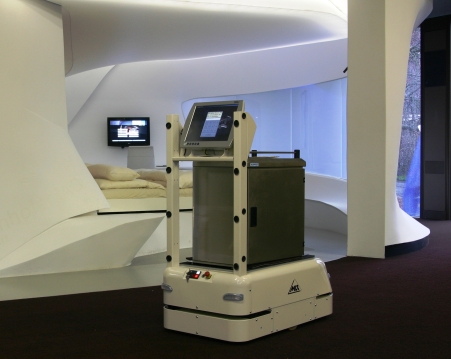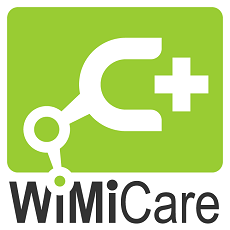Project Description
Supporting the Knowledge Transfer for a Participative Design of the Care Work Sector through Microelectronics (WiMi-Care).
A joint research project funded by the German Federal Ministry of Research and Technology (BMBF, support code: 01FC08024-27), which analyzes the transfer of knowledge for a demand oriented development of service robotic in the care sector. Duration: November 2008-October 2011
Problem:
The demographic change, a longer life time due to constant improvement of medical care, the increased requirements for quality of life, as well as the at a low level stagnating fertility rate have risen great challenges to the social security system and the integration capacity of society. Assuming demographic change offers significant opportunities for economy and employment, not only the question how to balance risks and problems is raised, but also how to use the potential of an aging society through appropriate microelectronic applications. Seniors are regarded as an economically important, rich in experience and competent group of our society, whose relevance will increase in the coming years. Within the field of microelectronic innovation the area of service robotics displays promising developments concerning better integration through higher levels of autonomy and relief of care workers. The growing international sales of service robots and the anticipated positive trend suggest a considerable potential in this segment.
Research institutions specialized on the development of service robots and the still young entrepreneurial activities in this field are confronted with / facing a number of difficulties: On the one hand a stronger relationship between research, development, production and distribution (business models) is required, on the other hand mandatory regulations (standardization) are missing. Furthermore intensive cooperation with the involved parties (elderly and care services) is necessary. Thus a demand driven development is reasonable. This procedure depends largely on adequate instruments for the determination of desiderata and usability.
Objective:
The aim of this joint research project is the development and generation of a "Knowledge-Transfer Loop" that involves developers, manufacturer, as well as the users of service robotics. This loop should be improved, where it already exists and created or professionalized through the development of appropriate survey tools (usability and user-research), where it does not exist yet. By involving potential users at an early stage of development and by implementing intensive pilot applications in a 'real-world' context (in a care facility), the progress should be targeted and optimized towards adequacy of needs. The project’s results are the actual production of a “Knowledge-Transfer Loop” the first place and, based on this, the efficient development of two service robots (Care-O-bot® 3 (IPA) and CASERO (MLR)). Furthermore the “Knowledge-Transfer Loop” should be exemplary for other innovations in service robotics and generate indirect surplus, which is supposed to lead to the generation of innovative micro-system technology. The constructed tools for usability (user friendliness) and user research (demand analysis) should be not only applicable in this project, but rather be applicable in the development and improvement of service robots in the care sector in order to make an important contribution to the standardization of relevant technologies and their applications.
Solution:
Numerous studies exist, which deal with the usability aspects in different contexts.The demand driven development has only limited access to existing experience, because the field of microelectronical service applications for the health and care sector is relatively young. Therefore the WiMi-Care project aims at analyzing the knowledge transfer processes at the developer-user interface to optimize the user-oriented development of microsystem technology. Focusing on knowledge creation and use, innovation can be designed suitable for the needs and can thus bear more prospects. The risks, which innovative efforts bring with, can be minimized through this focus. The aim is not to make corrections afterwards, but rather to design products and applications, whose acceptance is guaranteed, because they are created in cooperation with the users.
Several approaches are possible to make this specific knowledge ’visible' and ‘translate’ it into concrete (micro) technical requirements. Our central method of choice is the scenario based design, which is able to create this connective function between potential users and developers. With scenarios it is not only possible to illustrate the wishes of the customers and the technical determining factors in an ideal way, but also to derive technical requirements from this. To what extent this will be achieved for the application of service robots in the care sector and at which points improvements are necessary or possible, should be examined on the basis of demand analyses and through the concrete use of the developed devices. The experiences and wishes of the users are recorded, technically implemented and tested with the robots (Care-O-bot® 3 (IPA) and CASERO (MLR)). Especially the potential users’ feedback will be paid highest attention to in this part of the project. Subsequent the experiences, observations and feedback are incorporated in a second iteration in the further development of the service applications. This procedure should allow an optimized design of technology, which is explicitly oriented towards the needs of the users.

Care-O-bot® 3 - Mobile Robot Assistant - Fraunhofer IPA Stuttgart

CASERO - Automated Guided Vehicle System, MLR System GmbH, Ludwigsburg

